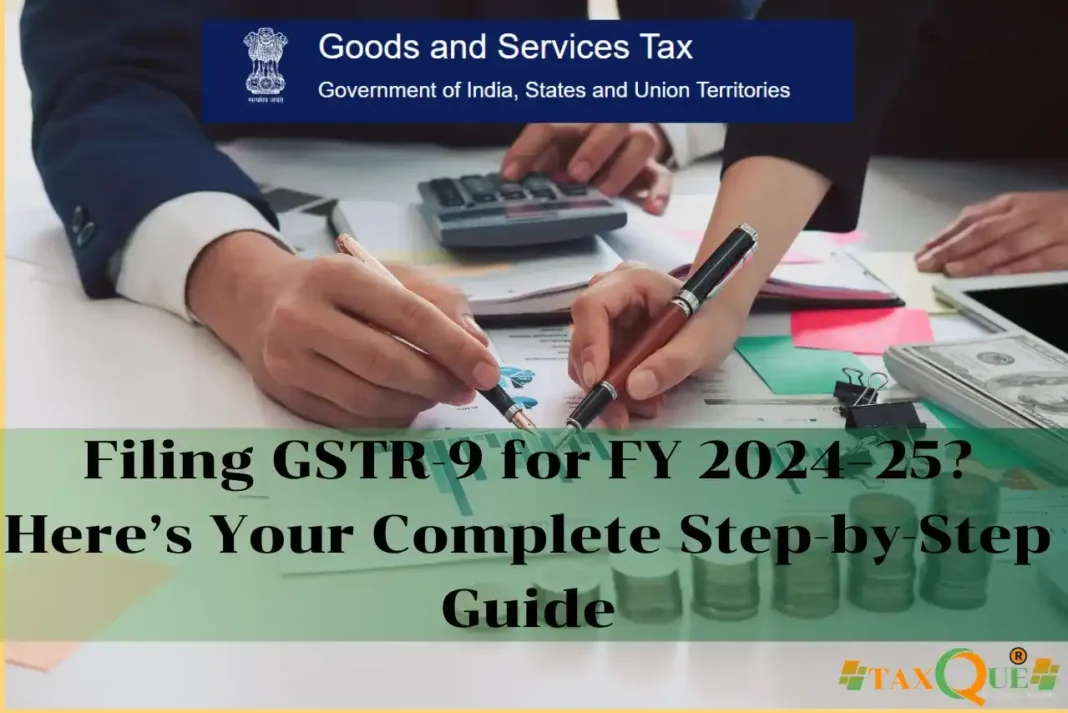Filing GSTR-9 for FY 2024–25? Here’s Your Complete Step-by-Step Guide
Introduction
GSTR-9 is the annual return that consolidates monthly or quarterly GST returns filed during the financial year. It serves as a final statement of your GST compliance for the year, detailing outward and inward supplies, tax paid, ITC claimed, and more. For many businesses, GSTR-9 filing can feel overwhelming due to its extensive data requirements. This blog will simplify the process with a clear step-by-step guide, covering who needs to file, when to file, and how to avoid common mistakes.
What is GSTR-9?
GSTR-9 is the annual return to be filed by every GST-registered taxpayer (except composition dealers, casual taxpayers, and non-residents) for a given financial year. It provides a consolidated summary of:
- Outward and inward supplies
- Taxes paid
- Input Tax Credit (ITC) claimed and reversed
- Demand and refunds
- Other adjustments
Why It Matters
- It reconciles the yearly data with monthly/quarterly filings.
- Ensures transparency and accuracy in GST compliance.
- Mandatory for businesses with annual turnover above ₹2 crore.
- Helps avoid penalties and departmental scrutiny.
Step-by-Step Guide to File GSTR-9
Step 1: Login to the GST Portal
Visit www.gst.gov.in and log in using your credentials.
Step 2: Go to Returns Dashboard
Choose the financial year for which you want to file GSTR-9.
Step 3: Select GSTR-9 and Click “Prepare Online”
Start preparing your annual return by clicking “Prepare Online.”
Step 4: Fill in the Required Sections
Data will be auto-populated from GSTR-1 and GSTR-3B wherever applicable. Verify and fill in:
- Details of outward and inward supplies
- ITC claimed and reversed
- Tax paid
- Transactions not reported earlier (if any)
- Demand/refund details
Step 5: Preview and Verify
Use the “Preview” button to download and review the draft GSTR-9 PDF. Verify all values against your books.
Step 6: Submit and File
Once confirmed, click “Submit” and then “File” using DSC or EVC.
Step 7: Download Acknowledgement
Download the GSTR-9 acknowledgement for future reference. ARN will be generated.
Common Mistakes to Avoid
- Relying only on auto-populated data without cross-verifying.
- Not disclosing unreported outward/inward supplies.
- Wrong ITC reporting or mismatch with GSTR-3B.
- Missing out on adjustments or previous year corrections.
- Filing with incorrect tax paid or refund data.
Conclusion
GSTR-9 is an important part of your GST compliance calendar. Filing it accurately ensures that your tax records are clean and verifiable. By following this detailed process and avoiding common errors, businesses can file GSTR-9 efficiently and stay compliant with Indian tax laws. Keep your books updated and reconcile data regularly to make annual filing hassle-free.
FAQs
Q1. Who is required to file GSTR-9?
All regular taxpayers under GST, except those under composition scheme, casual taxable persons, and non-resident taxpayers.
Q2. What is the due date for GSTR-9?
Typically, 31st December following the end of the financial year. (For FY 2024–25, due by 31st Dec 2025, unless extended)
Q3. Can GSTR-9 be revised after filing?
No, once filed, GSTR-9 cannot be revised.
Q4. Is filing GSTR-9 mandatory for businesses with turnover below ₹2 crore?
It is optional for such taxpayers, but recommended for reconciliation purposes.
Q5. Is GSTR-9C also required?
Only businesses with turnover exceeding ₹5 crore must file GSTR-9C (reconciliation statement audited by a CA).





